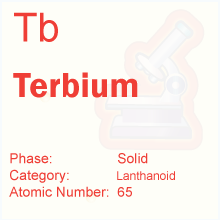 Periodic Table -> Terbium
Periodic Table -> TerbiumTerbium
Terbium DetailsTerbium Symbol: Tb
Terbium Atomic Number: 65
Terbium Atomic Weight: 158.924
What is Terbium?
Terbium (number 65, symbol Tb) is an earth metal and chemical element that can be extracted from minerals such as bastnaesite and monazite. It belongs to the group of lanthanides and was discovered in 1843 by Carl Mosander who also isolated erbium and lanthanum. He studied the mineral gadolinite which contains dysprosium, terbium, ytterbium, thulium, and yttrium, all of which being rare earth elements. Today the major mining sites are found in Australia, Brazil, China, Sri Lanka, India, and the United States. The largest site is found on the territory of Southern China.
Isotopes and Physical and Chemical Properties
Terbium is soft, ductile, malleable, and silvery-grey in color and oxidizes slowly. It occurs in minerals such as monazite, euxenite, xenotime, gadolinite, and cerite. The metal reacts with different elements at high temperatures, including arsenic, silicon, and carbon. Compounds such as terbium hydride and terbium telluride are formed. The most common oxidation state is +3. Other oxidation states include 1, 2, and 4. The isotopes are 9 in total. There are 36 radioisotopes, including Tb-157, Tb-158, Tb-135, Tb-171, and others. Tb-171 is the heaviest known radioisotope while Tb-158 is the most stable synthetically produced isotope. Some of the isotopes have a short half life of less than 30 seconds. The nuclear isomers are 27 in number, and Tb-156m is the most stable isomer. This element has a hexagonal close-packed structure and forms fluorides, iodides, bromides, and chlorides. The Vanderwaals and ionic radius are unknown. Its boiling point is 5505 °F (3041°C), and its melting point is 2480 °F (1360 °C)

The metal is used as a dopant in different compounds, including strontium molybdate, calcium tungstate, and calcium fluoride. In general, there are few uses because the element is expensive and rare. It is mainly used in fuel cells, television tubes, semiconductor and electronic devices, and lasers. The metal is also used in magnetomechanical devices, sonar systems, actuators, and alloys. In addition, the element is used to make high definition screens and lighting fixtures, including trichromatic lighting.Terbium has applications in biochemistry as well. Together with UV light, its ions are used to detect microorganisms. Tb ions also make it possible to detect counterfeit banknotes. Magnets for hybrid vehicles contain an alloy of dysprosium, terbium, and neodymium. Wind turbines that are powered by electric motors also contain magnets. They generate energy at high temperatures. Electrolysis and reduction are used to produce the metal. Calcium metal is used to reduce anhydrous chloride or fluoride. It is also obtained from monazite sand, euxenite, and xenotime. It doesn’t occur as a free element but is found in different ores. The annual world production totals 10 tonnes.
Environmental and Health Effects
The element is mildly toxic but its compounds irritate the eyes and skin. It is not considered environmental hazard and poses no threat to plant and animal life. It has no biological role and is difficult to isolate. Further research on toxicity is required.
You can
link to this page, using the code below:
Periodic Table |
Banks
© ElementsDatabase.com 2015 | Privacy | About | Contact